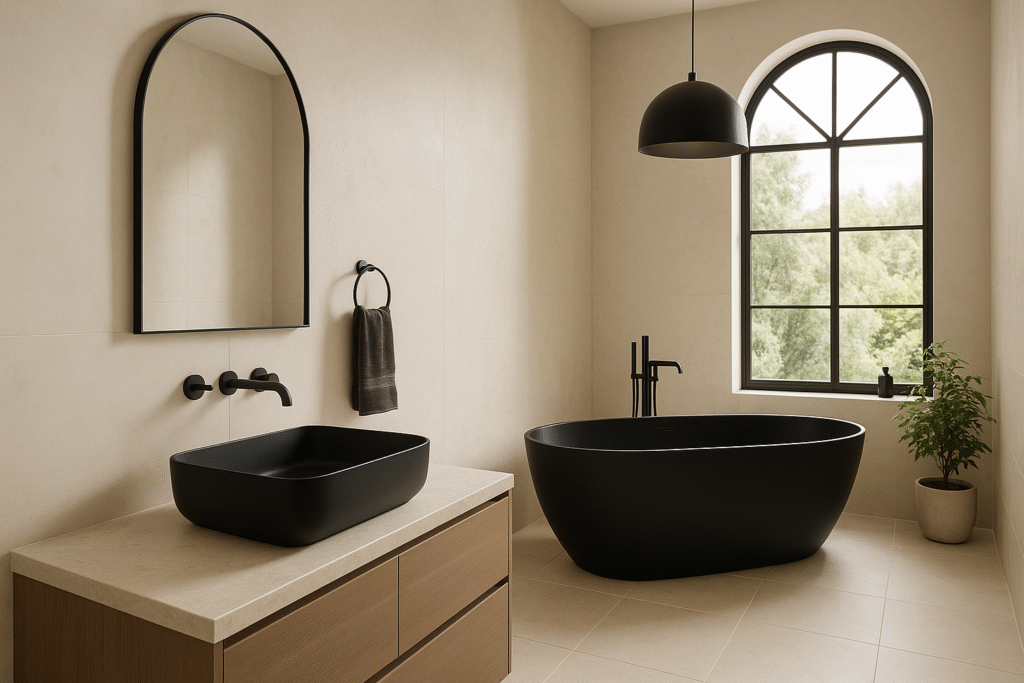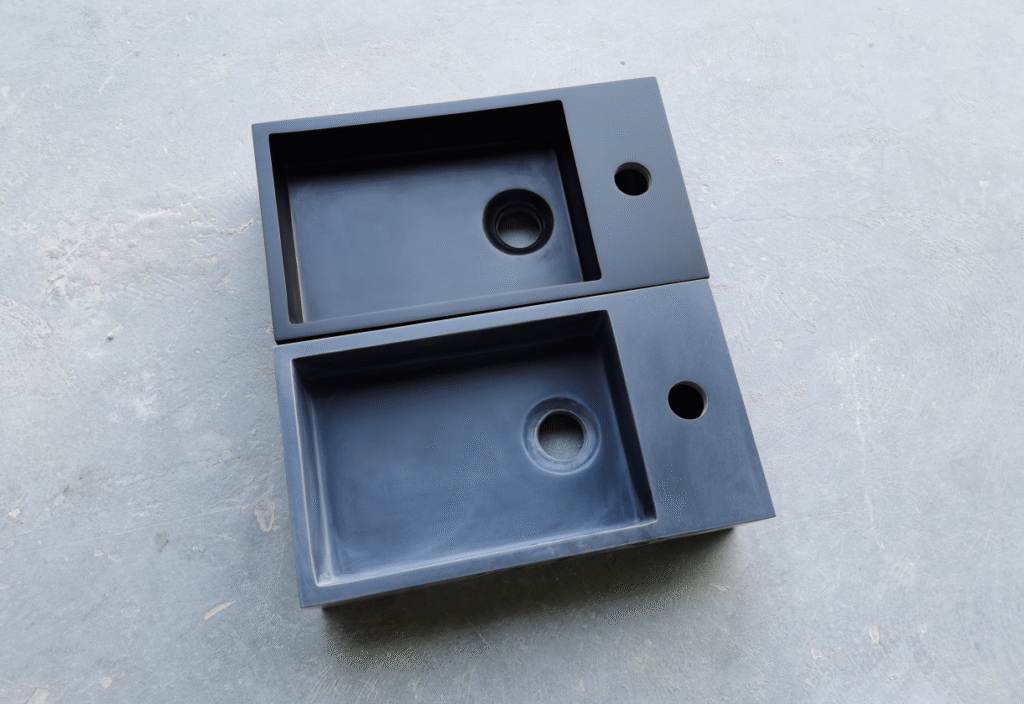Black basins and bathtubs are the centerpiece of many modern bathrooms. Their bold, elegant appearance instantly elevates the space, especially in matte or satin finishes. However, many homeowners and hoteliers face one recurring issue over time — the black surface begins to turn white, appearing cloudy, patchy, or chalky.
This whitening effect can make even a luxury bathroom look worn or poorly maintained. The good news? It’s not permanent. Black solid surface products are renewable — meaning they can be repaired and restored to their original deep black tone with proper care.


In this guide, we’ll explore why whitening happens, how to fix it, and the best long-term maintenance methods to keep your black bathroom basin and bathtub looking flawless.
Why Black Basins and Bathtubs Turn White
Black sanitary products — especially those made of solid surface — are durable but not immune to environmental and cleaning-related effects. Here are the most common reasons for whitening or fading:
- Hard Water Mineral Build-Up
When water evaporates, it leaves behind calcium and magnesium deposits that appear as white film, particularly visible on black matte finishes. - Improper Cleaning Products
Strong cleaners containing bleach, alcohol, acid, or abrasive powders damage the resin layer of the solid surface, causing a cloudy, faded look. - Surface Micro-Scratches
Using rough sponges or metal scrapers can create microscopic scratches that scatter light — visually dulling the black surface. - Soap and Detergent Residue
Leftover body wash, shampoo, or detergent can dry unevenly, leaving light streaks or dull spots. - UV and Heat Exposure
Prolonged exposure to sunlight or high bathroom temperatures can slightly oxidize the top layer, leading to color shift or whitening.
Good to know: Whitening on solid surface black basins and tubs is reversible through gentle restoration — a key advantage over coated or enamel surfaces.
Step-by-Step: How to Fix Whitening on Black Basins and Bathtubs
The following process is derived from KKR®’s factory-tested maintenance guide. It uses safe, easy-to-find materials and works for both matte and semi-gloss solid surface finishes.
Step 1 – Prepare Tools and Materials
You’ll need:
- A soft microfiber cloth
- A small amount of hand cream or neutral restoration paste
- Mild warm water
- (Optional) Fine sandpaper (800 – 1200 grit) for heavier whitening
🛑 Avoid abrasive cleaners, steel wool, or strong chemical detergents.


Step 2 – Apply Restoration Cream
This step nourishes the resin layer of the solid surface, restoring its natural pigment depth and eliminating the chalky appearance.
Put a pea-sized amount of hand cream or restoring paste directly on the whitened area.
Use the microfiber cloth to rub gently in circular motions, evenly spreading the cream across the faded surface.
Pro Tip: For matte finishes, apply in light pressure to maintain the non-glossy texture. For glossy surfaces, you can add slightly more buffing motion for shine balance.


Step 3 – Allow to Absorb, Then Rinse
Let the product rest for 5 – 10 minutes to allow full absorption.
Afterward, rinse lightly with warm water and wipe completely dry.
You’ll notice the whitened patch darken back to its original black tone, regaining a smooth, even look.
Step 4 – For Severe Whitening or Scratches
If whitening remains visible after cleaning and rehydration:
- Lightly sand the affected zone with 800 – 1200 grit sandpaper, following a circular motion.
- Wipe away dust and apply a thin layer of cream or surface restorer again.
- Allow it to cure, then buff with a clean soft cloth.
For widespread or deep discoloration, professional refinishing may be required. Solid surface black materials are easily renewable through machine polishing or re-sanding, unlike enamel or painted finishes.


Daily Maintenance Tips to Prevent Whitening
- Use pH-Neutral Cleaners Only
Always clean with mild detergent or diluted soap solution. Avoid acid, ammonia, alcohol, and chlorine. - Wipe Dry After Use
Prevent mineral stains by towel-drying your basin and bathtub after every use — especially in hard-water areas. - Avoid Heat and Sunlight
Direct UV rays can accelerate oxidation on matte surfaces. Use blinds or curtains in naturally lit bathrooms. - Clean Weekly
Regular cleaning prevents soap scum and mineral accumulation that causes whitening. - Re-Apply Protective Layer
Every 2 – 3 months, gently rub a small amount of hand cream or surface balm to keep the finish rich and uniform. - Use Soft Accessories
Choose silicone or rubber mats in your bathtub to prevent friction scratches from metal items or tools.
Matte vs. Glossy Black: Care Differences
| Finish Type | Ideal Cleaning Routine | What to Avoid | Result |
|---|---|---|---|
| Matte Black | Wipe with neutral cleaner + apply small amount of hand cream quarterly | Over-polishing (causes shiny patches) | Soft, even tone |
| Glossy Black | Polish lightly with fine paste + buff microfiber | Abrasive pads or dry wiping | Deep mirror-like shine |
| Textured / Stone Black | Clean with neutral cleaner + sealant spray | Wax-based cleaners | Natural matte stone look |
Pro Insight: Matte black requires more frequent gentle maintenance than glossy finishes because surface pores trap more residue.
Advanced Tips for Solid Surface Black Basins & Bathtubs
KKR®’s solid surface technology makes every black basin and bathtub renewable, non-porous, and UV-resistant.
That means even years later, whitening or dullness can be fixed through simple maintenance.
Key Advantages:
- Color Stability: Pigments and resin are mixed evenly, not coated on the surface.
- Repairable Finish: Light sanding or buffing restores the surface easily.
- Seamless Integration: Ideal for modern minimalist bathrooms without visible joints.
- Eco-friendly Lifespan: No replacement needed — simply refinish.
If your project involves large installations such as hotels or apartments, periodic professional maintenance ensures all black basins and tubs maintain consistent tone and sheen.
FAQs
Q1: Can I use vinegar or lemon cleaner on black basins?
A1: No. Both are acidic and will dull matte black finishes over time. Always use neutral soap or professional surface cleaner.
Q2: How do I restore my black bathtub’s shine after cleaning?
A2: Apply a small amount of surface restorer or cream and buff gently. For glossy finishes, use fine polishing paste for extra reflection.
Q3: My matte black sink turned grey. Can I fix it?
A3: Yes — start with gentle cleaning, apply cream, and if needed, do a light wet sanding with 1000-grit sandpaper before re-applying.
Q4: How often should I perform full maintenance?
A4: Every 2–3 months for domestic bathrooms; monthly for hotels or high-traffic spaces.
Conclusion
Black basins and bathtubs add a timeless sophistication to any bathroom — but maintaining their deep tone requires care. Whitening, haze, or chalkiness are common signs of mineral buildup or mild oxidation, not permanent damage.
By following this guide — clean gently, restore regularly, and avoid harsh chemicals — your black solid surface bathroom products will stay as stunning as the day they were installed.
KKR®’s durable, repairable materials make it easy to renew color and texture whenever needed, ensuring that your matte or glossy black bathroom remains the highlight of your design for years to come.




